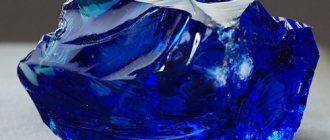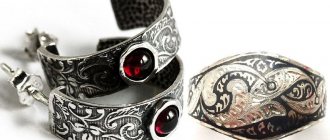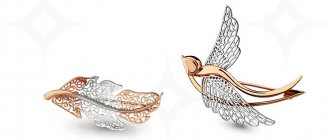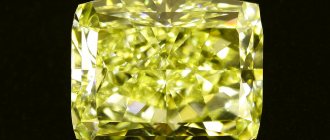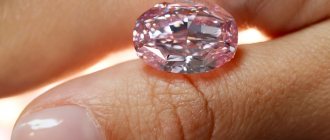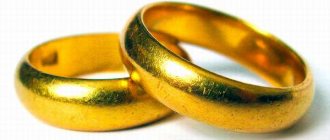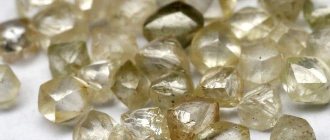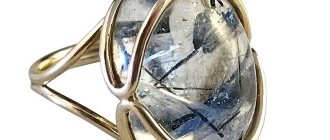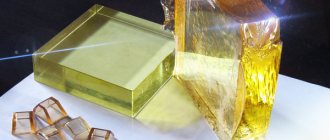Accessories are not just pretty. It seems that the minerals are barely audibly humming a melody, creating an emotional background. Maybe it's Rammstein - and today you're rebelling? Or the ring purrs an Adele song. Not that important. It's a shame if the stone falls out and the melody stops. Or she was initially quiet, because the stone was sent “to the crowd.” In a word: setting is important. And before you buy jewelry, read our tip on basic (and innovative) types of stone settings.
Setting - a method of fastening a stone
, installing it in the frame. This is a complex process. It cannot be automated. In factories, stones are often set by hand. Moreover: setters are considered the elite of the jewelry world. How the mineral will look depends on them. And will he play his “solo” with full dedication? In total, fastenings are divided into three types: prong, blind and corner.
Blind fastener
Deaf
. The stone is set directly into a special socket in a metal frame, which “hugs it tightly.” The ideal type of fastener for daily wear. This method has an interesting subtype called “Roma setting”. Its essence is that the metal covers the stone slightly from above. The mineral is “recessed” inside the ring. This guarantees the safety of the stone.
Minuses:
- Light falls on the stone only from above, so blind setting is more often used for opaque stones.
- This setting is the easiest way to hide doublets and triplets (glued layers of thin strips of glass and stone). Strictly speaking, this is not a fake, but the tag should indicate that a doublet was used in the decoration. Often they don’t do this, showing only the upper part of the insert, keeping silent about its “ins and outs”.
The best
The largest diamond ever found and cut is the Golden Jubilee Diamond. Its weight, just imagine, is 545.67 carats. Found in 1985, it lost relatively little weight during cutting. This stone was given to the King of Thailand for his 50th birthday, hence the name. Now it is set into the ruler's scepter.
Today, the title of the largest ruby on Earth belongs to an as yet unnamed beauty found in northern Greenland. Its leadership is undeniable, because its weight is 440 carats, and even after cutting, according to rough estimates, it will decrease to only 380 carats. While the Rosser Reeves ruby was considered the largest ruby up to this time, with its weight of 138 carats it seems quite miniature compared to the find.
But the largest sapphire can unconditionally be called the “Millennium Sapphire”; its weight reaches 61,500 carats. A unique stone was found on the island of Madagascar. Italian artist Alessioe Boschi engraved the faces of 134 great personalities on it, including Shakespeare, Einstein, Beethoven, Martin Luther King Jr. This unique monument to human genius is estimated at $180 million. But the Jewel of the Jungle sapphire is considered by jewelers all over the world to be the only example of an ideal, pure, deep blue color among all sapphires.
The largest emerald was involved in litigation. The largest piece of emerald, called Bahia, was found in Brazil. It consists of a huge number of emerald crystals encased in rock. Its weight is 1.9 million carats, the estimated value is from 400-900 million dollars. The legal battle over ownership of the stones is considered one of the largest property rights lawsuits in California history. 8 people claim their rights to a wonderful mineral.
CRAP STACK
Krapanovaya
. Claws or hooks wrap around the stone, putting the emphasis on it rather than the ring itself. Rays of light pass through the stone from all sides, creating an amazing shine and shine. This insert is easy to clean. Also, prong setting makes it possible to see the presence of defects in the stone. By the way, recently it has become fashionable for designers to fasten the stone with the tenon pointing up. And this practice is already being applied in the jewelry mass market. You'll see - don't be surprised. Enjoy!
Minuses:
- The reliability of the fastening is less than that of the blind method.
- The pebble can cling to clothes and hair.
- The edges of the paws can rub and wear out with daily wear.
General principles and rules for work
The process of attaching precious inserts to jewelry is a responsible undertaking that requires good physical strength, perseverance and precision from the master. All work is done entirely by hand. To do this they use various tools:
- calipers;
- jewelry vice;
- thermal paste;
- drill.
To set the stones you will need a caliper.
First, the stones are carefully inspected for defects. The product is prepared with a seat using a drill. Next, in the case of prong setting, the “legs” are adjusted. Pebbles are inserted into them and clamped well. It is important not to press too hard when clamping, otherwise the insert may simply crack, and if you do not press too hard, the mineral will wobble or even fall out.
TIFFANY&CO CLAMP
This is a type of crapone. But if the “classic” setting has four teeth, then the Tiffany setting
- six.
They are barely noticeable, allowing light to penetrate into the very heart of the stone and burst out, creating a halo of radiance around the ring. Plus, thanks to its “high” setting, the stone seems to float above the ring. Such jewelry is called solitaires
(the mineral acts as a soloist and does not need extras).
By the way, it was Tiffany that at one time introduced the fashion for engagement rings with diamonds. There were no standards before 1866. But Charles Tiffany decided that such things should not be left to chance. The best option for a declaration of love: a symbol of purity and eternity - a diamond. He must attract attention to himself, wrest the cherished consent. In a word, discourage. This is how the Tiffany setting was born: the most simple design that focuses attention on the stone. And judging by the fact that the solitaire has become the standard for an engagement ring
, Tiffany's plan is working.
Cons : identical to the classic crown setting
What could be more expensive than a diamond?
The cost of stones is usually determined by several parameters: weight, clarity, absence of defects and quality of cut. Yes, of course, diamond has a high hardness, 10 out of 10 on the Mohs scale. And, of course, it is valued for the unique play of light that shines when light hits its edges. But there are stones in the world more expensive than diamonds. Rubies, sapphires and emeralds. The most valuable emeralds are those that have a rich, deep green color. But rubies can be light pink and dark cherry. Sapphires are in demand if they have a blue-blue color, without yellowness or grayness.
PAVE SETTING
Pavé (pavement)
. Used to install a large number of small stones, creating the effect of a sparkling smooth surface. To do this, small niches are drilled into the metal for each mineral. Very popular in designer jewelry, but also common in our latitudes. One of the aesthetic subtypes of pavé is snow setting. The stones are fixed at a certain distance from each other and create the effect of a melting snowflake. Looks great.
Minuses:
- A complex technique that requires a painstaking approach and the skill of a jeweler-setter. Due to poor workmanship, stones may fall out of the jewelry.
- It is often almost impossible to change the ring size.
Fastening using metal posts - corners
The most popular method for attaching small minerals into rings. The maximum permissible stone diameter for setting is 4 mm. Two types of corner castes are used in jewelry making:
- Open - the insert is simultaneously held by the corners and walls of the setting.
- Built-in - square (the insert is fixed in the center of the square plate using 4 corners); faden (the stones are arranged in a row, almost touching the girdles); Tick (chaotic fastening of inserts of different sizes).
Setting occurs by first creating small depressions on the smooth surface of the metal, where the stone is subsequently installed. The spherical top of the corner prevents the stone from sliding and moving.
Advantages of root tack:
- Visual enlargement of the insert.
- Corners allow you to hide stone defects.
- Applying undercuts, notches and ribs on a gold plate allows you to create a spectacular strip of uniformly laid out gems.
RAIL FASTENING
Channel (rail)
. The stones are fixed into a special channel (rail). It is soldered along the edges of the metal. The method is used for transparent stones through which light passes beautifully. At the same time, the inserts are protected from impacts and do not cling to clothing.
Minuses:
- Due to close contact, chips may occur on the stones.
- Requires regular cleaning by a jeweler.
- Difficult to change ring size.
ADHESIVE FITTING
Adhesive
. Used for complex-shaped stones, round minerals, amber and pearls. To do this, a hole is made in the insert in advance, then the stone is placed on a special pin and secured with glue for reliability.
Minuses:
- Necessity of careful cleaning at the jeweler.
- The decoration is “afraid” of water. If you get caught in the rain, it’s not a problem, but you shouldn’t wash the dishes in full dress.
ROOT FITTING
Corner
. The stone is placed not in special niches, but directly in the metal between peculiar columns (corners). To do this, holes are made in advance. One of the most difficult types of setting. Most often used for small stones.
Minuses:
- High labor intensity and, as a result, the cost of decoration.
- It is almost impossible to change the size of the jewelry.
INNOVATIVE FITTING
Designer
.
Every self-respecting jeweler develops his own type of setting. This is how Swiss designers use stone setting in stone
.
The contrast between minerals enhances their beauty. Plus, you can play with color using gems and mother-of-pearl. This type of setting
was popular back in Ancient Egypt. It was later forgotten and only recently revived in Europe. Stones in a jewelry glass case can hardly be called setting. But on the other hand: what should we call it? In any case, jewelry cases are now at the peak of popularity. They look unusual and allow the stones to play with the palette, not paying attention to conventions and boundaries.
Setting is one of the indicators of the value of a product. And now that you have become an expert, you can easily choose the appropriate option. The Zlato.ua catalog presents a wide selection of both engagement rings and simply chic products that will highlight your individuality.
Casting with stones - a revolution in the world of inlaying
This is a technology in which metal in a molten state is combined with a precious stone. As a result, the insert holds as firmly as possible in the modern world.
The product can contain one or several stones.
The AQUAMARINE company was one of the first in Russia to master the method of casting with stones.
